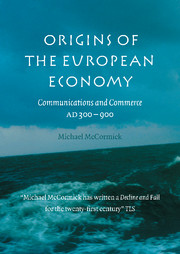Book contents
- Frontmatter
- Dedication
- Contents
- List of maps
- List of figures
- List of tables
- List of charts
- Preface
- List of abbreviations
- Commerce, communications, and the origins of the European economy
- PART I THE END OF THE WORLD
- PART II PEOPLE ON THE MOVE
- 5 A few western faces
- 6 Two hundred more western envoys and pilgrims: group portrait
- 7 Byzantine faces
- 8 Easterners heading west: group portrait
- 9 Traders, slaves, and exiles
- People on the move
- PART III THINGS THAT TRAVELED
- PART IV THE PATTERNS OF CHANGE
- PART V COMMERCE
- Appendices
- Bibliography
- Index
6 - Two hundred more western envoys and pilgrims: group portrait
from PART II - PEOPLE ON THE MOVE
Published online by Cambridge University Press: 05 February 2015
- Frontmatter
- Dedication
- Contents
- List of maps
- List of figures
- List of tables
- List of charts
- Preface
- List of abbreviations
- Commerce, communications, and the origins of the European economy
- PART I THE END OF THE WORLD
- PART II PEOPLE ON THE MOVE
- 5 A few western faces
- 6 Two hundred more western envoys and pilgrims: group portrait
- 7 Byzantine faces
- 8 Easterners heading west: group portrait
- 9 Traders, slaves, and exiles
- People on the move
- PART III THINGS THAT TRAVELED
- PART IV THE PATTERNS OF CHANGE
- PART V COMMERCE
- Appendices
- Bibliography
- Index
Summary
On 3 November 869, the Roman monk Peter was summoned to the church council then under way in the Hagia Sophia. In the presence of the Byzantine emperor and Roman legates, the man was accused of participating in Photius' synod which, two years before, had deposed Pope Nicholas I. He denied everything. For the historian of Mediterranean communications, his defense is striking: “So am I the only Peter who comes up to this city from Rome? What about the other 10,000 Peters who have come up [here]?” Although Peter may not win points for mathematical precision, his defense assumes a fair crowd of similarly named Romans at Constantinople in 867. The monk's forgotten protest challenges the notion of a ninth-century Mediterranean empty of communications and contacts. Closer scrutiny of the larger group of western pilgrims and envoys deepens that challenge.
Basic facts
Including Amalarius, Marinus, Willibald, and Bernard, I have been able to discern 239 individual envoys or pilgrims who traveled, or who intended to travel from western Europe into the eastern Mediterranean between c. 700 and 900. A majority belonged to an embassy. This hints, again, at the role of social prominence in creating the documentary record.
- Type
- Chapter
- Information
- Origins of the European EconomyCommunications and Commerce AD 300–900, pp. 151 - 173Publisher: Cambridge University PressPrint publication year: 2002



